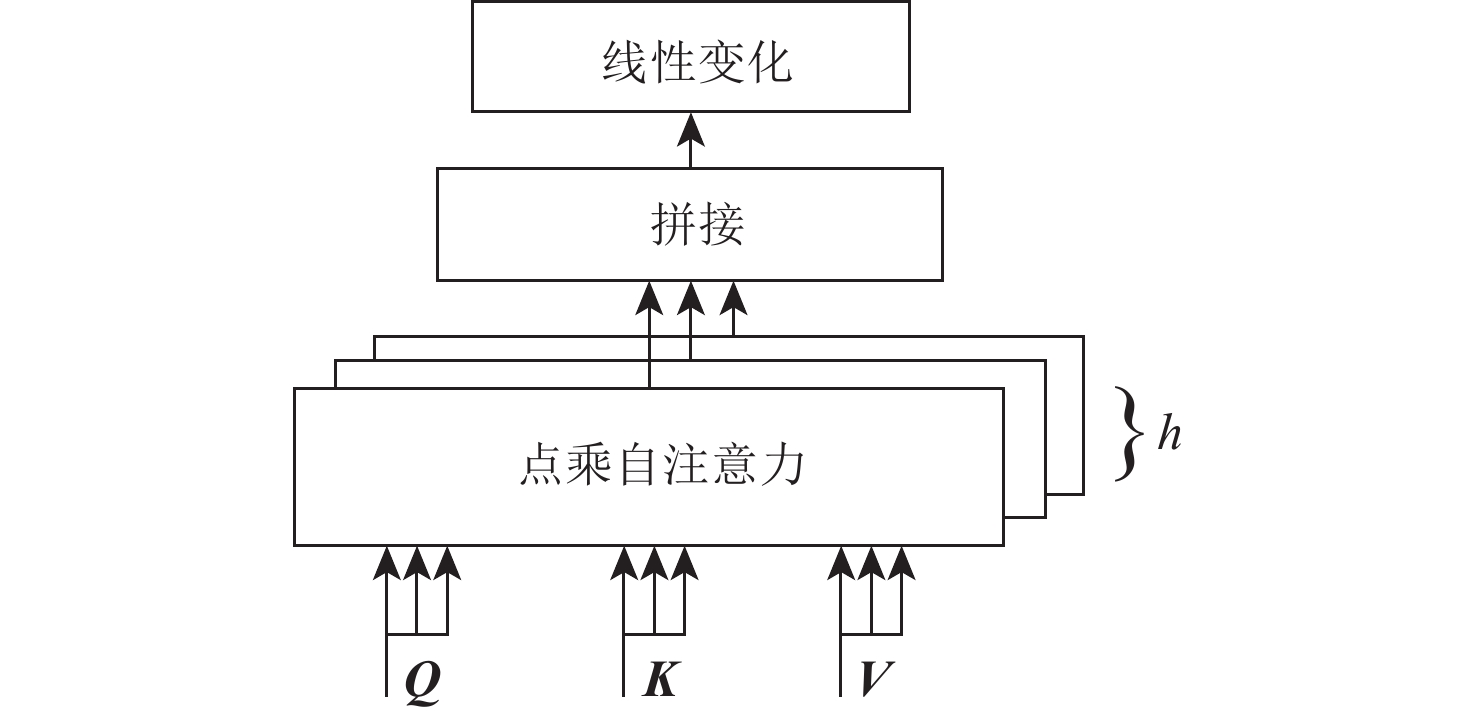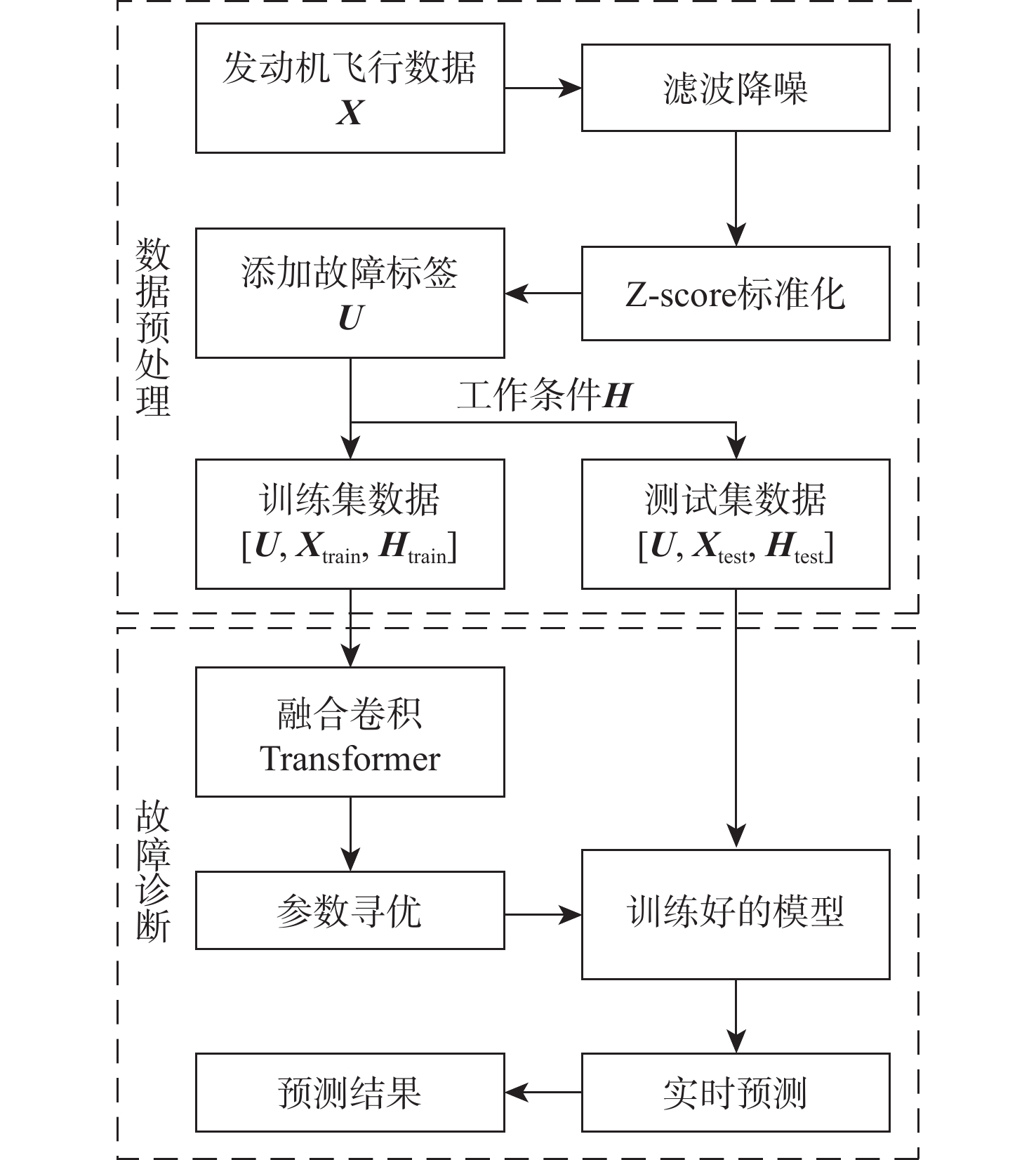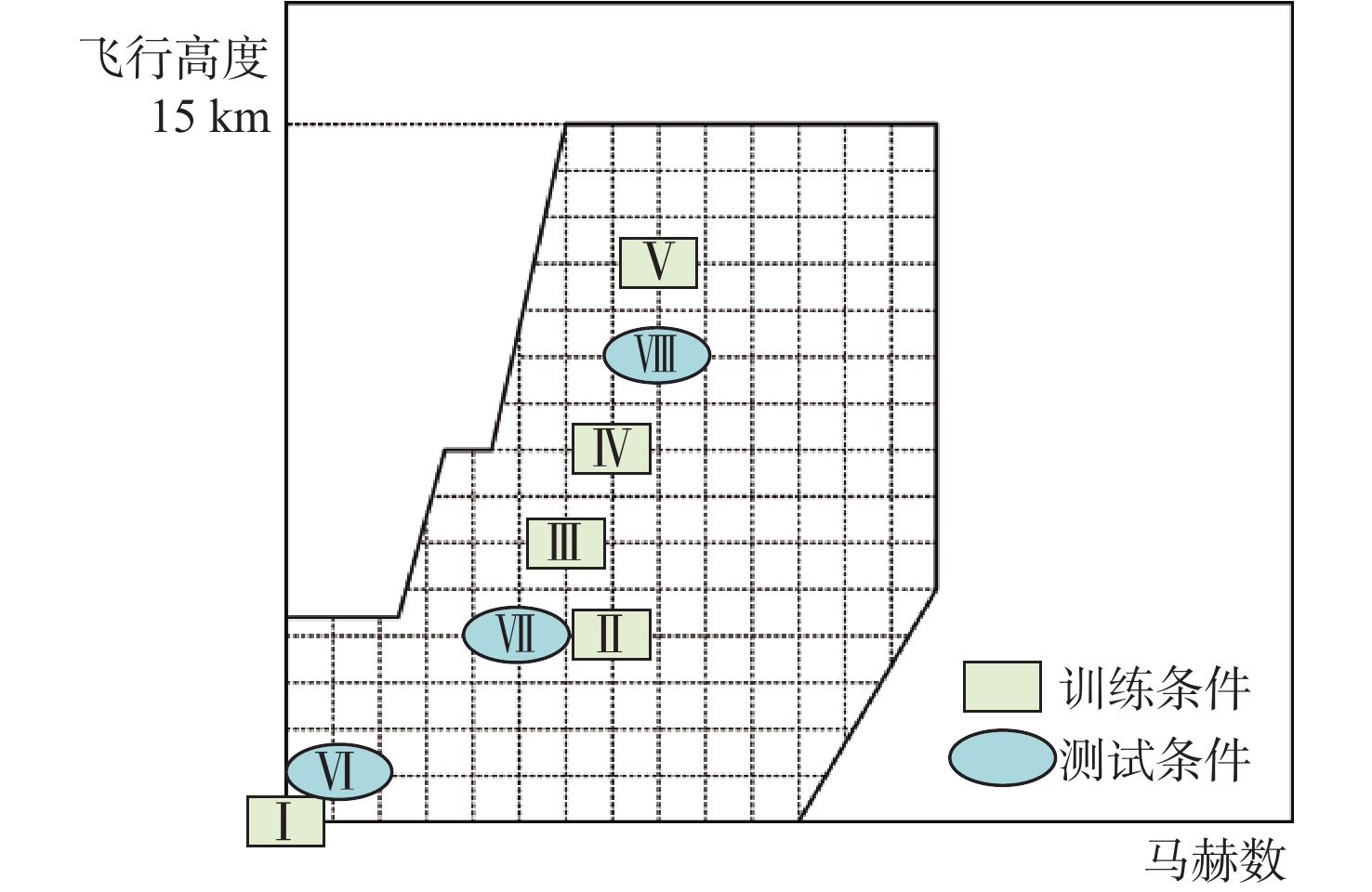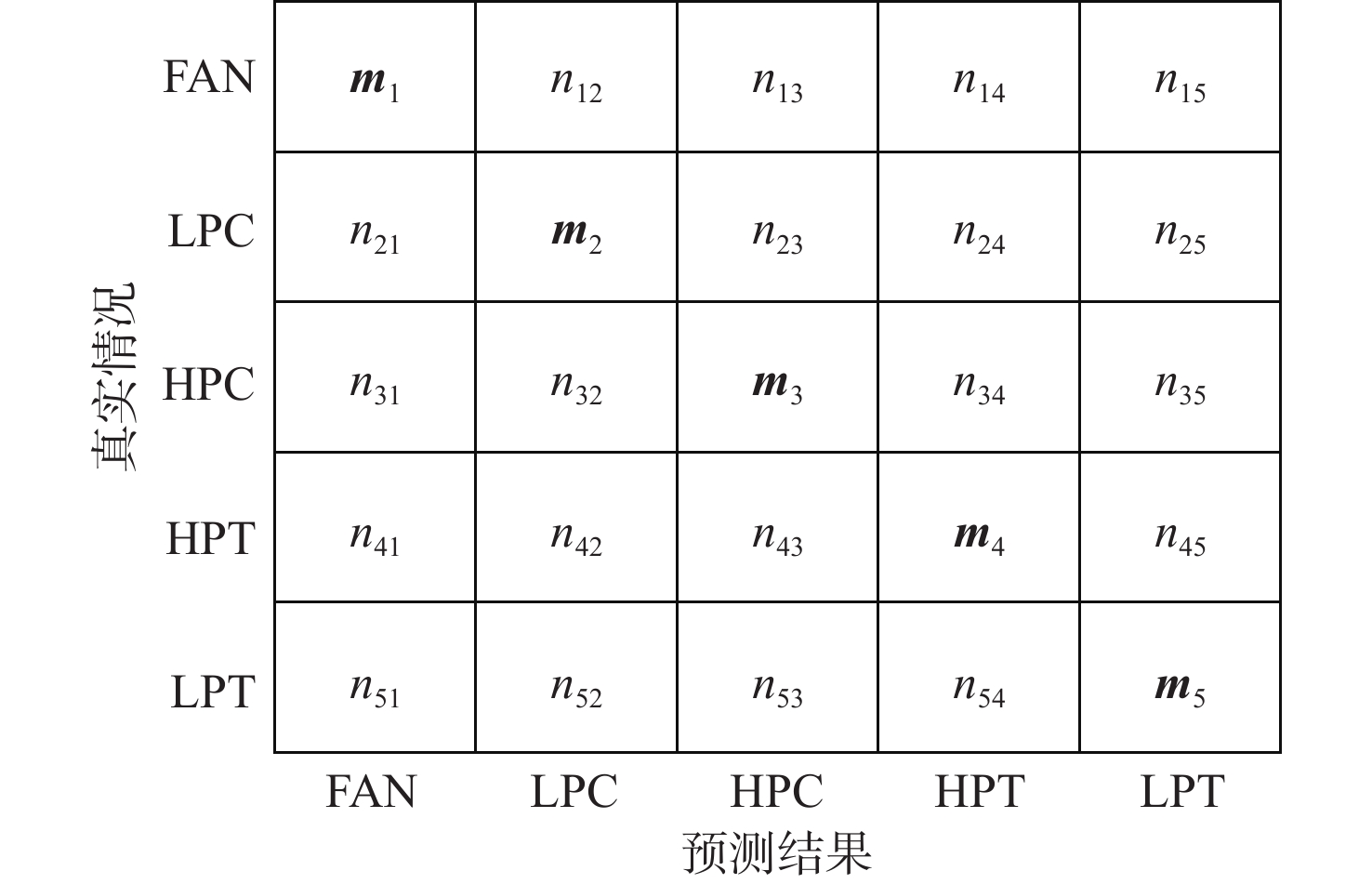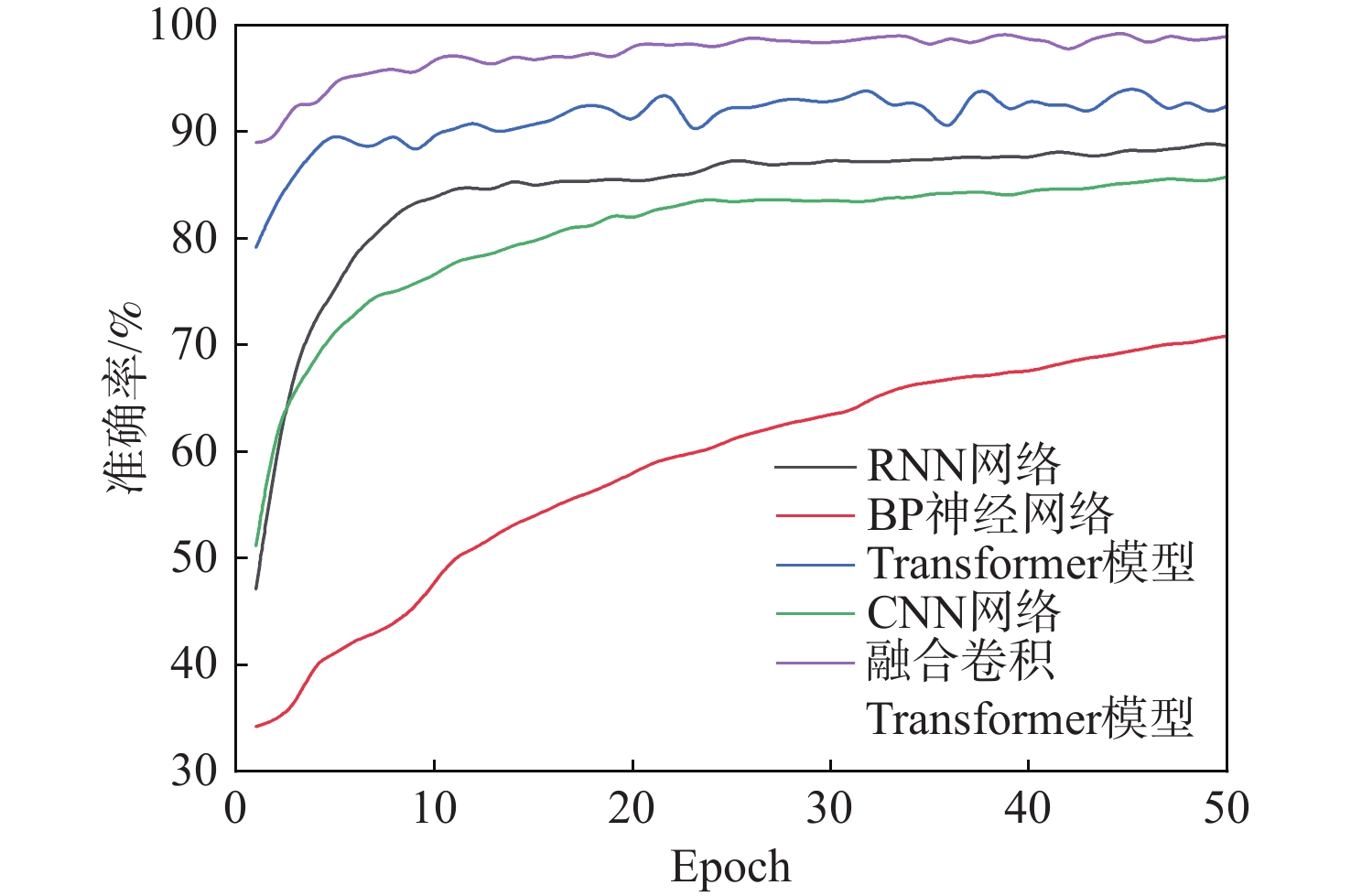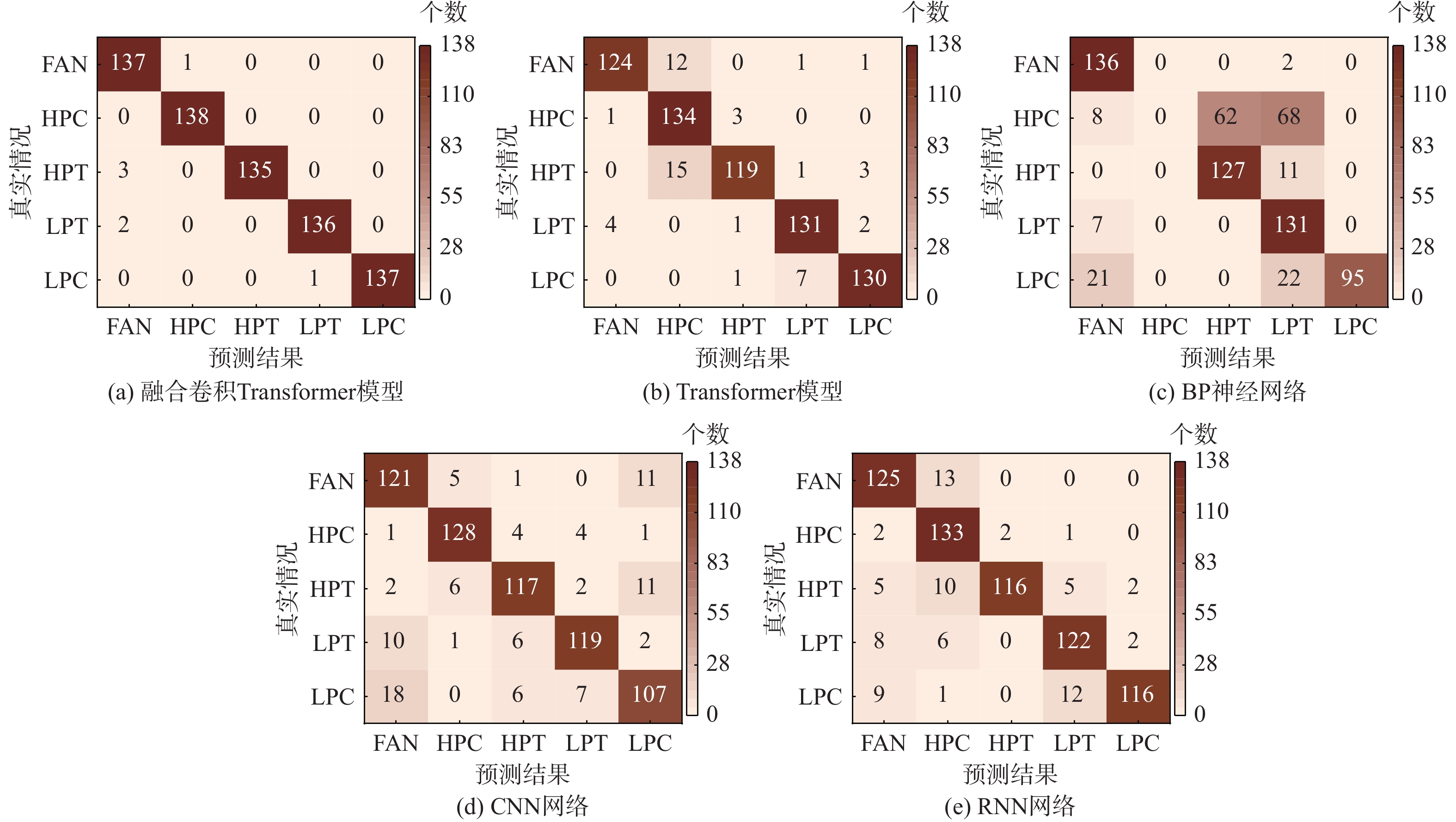-
摘要:
航空发动机长期处于恶劣的气路环境下工作会面临腐蚀、侵蚀等问题,且故障参数特征不明显,因此,精准的航空发动机故障诊断方法对保证飞机安全运行具有重要意义。为提高预测准确性,提出了一种基于融合卷积Transformer的航空发动机故障诊断方法。利用自注意力机制提取有用特征,抑制冗余信息,并将最大池化层引入Transformer模型中,进一步降低模型内存消耗及参数量,缓解过拟合现象。采用基于GasTurb建模的涡扇发动机仿真数据集进行验证,结果与Transformer模型和反向传播(BP)神经网络、卷积神经网络(CNN)、循环神经网络(RNN)等传统深度学习模型相比,准确率分别提高了6.552%和28.117%、13.189%、10.29%,证明了所提方法的有效性,可为航空发动机故障诊断提供一定的参考。
-
关键词:
- 航空发动机 /
- 故障诊断 /
- 自注意力机制 /
- 融合卷积Transformer /
- 深度神经网络
Abstract:Aero-engine faces the problems of corrosion and erosion when working in an atmospheric environment for a long time, and the features of fault parameters are not obvious. Therefore, an accurate aero-engine fault diagnosis method is of great significance to ensure the safe operation of aircraft. To improve the prediction accuracy, an aero-engine fault diagnosis method based on a fusion convolutional Transformer was proposed, which used the self-attention mechanism to extract useful features and restrain redundant information. In addition, the MaxPool was introduced into the Transformer model to reduce the model memory consumption further and the number of parameters and mitigate overfitting. The turbofan engine simulation dataset based on GasTurb modeling was used for verification. Compared with Transformer network and other traditional deep learning models, such as back propagation (BP) neural network, convolutional neural network (CNN), and recurrent neural network (RNN), the proposed model has improved prediction accuracy by 6.552%, 28.117%, 13.189%, and 10.29%, which proves its effectiveness, and it can provide a reference for aero-engine fault diagnosis.
-
表 1 部件属性参数
Table 1. Property parameters of engine components
部件属性参数 设定值 进气道总压恢复系数 0.99 涵道比 8 风扇转速/(r·min−1) 4000 风扇增压比 1.702 风扇效率/% 0.8780 LPC转速/(r·min−1) 4000 LPC增压比 4 LPC效率/% 0.8700 HPC转速/(r·min−1) 18000 HPC增压比 7 HPC效率/% 0.8500 燃烧室燃烧效率/% 0.9995 燃烧室总压恢复系数 0.95 HPT转速/(r·min−1) 18000 HPT效率/% 0.88 HPT落压比 2.816 LPT转速/(r·min−1) 4000 LPT效率/% 0.9000 LPT落压比 7.166 表 2 航空发动机参数规范
Table 2. Parameter specification of aero-engine
故障部件 健康指数/% 样本数量 FAN E1, W1∈[−0.5, −5.0] 5152 LPC E2, W2∈[−0.5, −5.0] 5152 HPC E3, W3∈[−0.5, −5.0] 5152 HPT E4∈[−0.5, −5.0],
W4∈[0.5, 5.0]5152 LPT E5∈[−0.5, −5.0],
W5∈[0.5, 5.0]5152 表 3 模拟参数的测量噪声范围
Table 3. Range of measurement noise for simulated parameters
状态参数 数值 燃油流量WFF标准噪声值/(kg·s−1) 0.0176 进口总温T2标准噪声值/K ± 2.6 进口总压P2标准噪声值/% ± 0.5 风扇出口总温T13标准噪声值/K ± 2.6 风扇出口总压P13标准噪声值/% ± 0.5 HPC入口总温T25标准噪声值/K ± 2.6 HPC入口总压P25标准噪声值/% ± 0.5 HPC出口总温T3标准噪声值/K ± 3.3 HPC出口总压P3标准噪声值/% ± 0.5 LPT入口总温T45标准噪声值/K ± 9.38 LPT入口总压P45标准噪声值/% ± 0.5 LPT出口总温T5标准噪声值/K ± 6.64 LPT出口总压P5标准噪声值/% ± 0.5 高压转子转速N2标准噪声值/% ± 0.1 表 4 航空发动机各类故障标签
Table 4. Various fault labels for aero-engine
故障种类 故障标签 FAN故障 0 HPC故障 1 HPT故障 2 LPT故障 3 LPC故障 4 表 5 不同自注意力头数的对比结果
Table 5. Comparison results of different self-attention heads
h F1值 准确率/% FAN
故障HPC
故障LPC
故障HPT
故障LPT
故障1 0.97842 0.97183 0.97778 0.98901 0.99636 98.261 2 0.98208 0.97872 0.98155 0.98901 0.99636 98.551 7 0.97857 0.98924 0.98901 0.97841 0.97037 98.116 14 0.97509 0.94891 0.95341 0.97778 0.99275 96.957 表 6 不同编解码器层数的对比结果
Table 6. Comparison results of different encoder and decoder layers
编解码器层数结构 运行时间/s 准确率/% 损失函数值 5+5 140.02 98.986 3.5434 5+6 170.99 98.986 3.7686 5+7 180.64 98.551 5.0131 6+5 163.97 98.696 4.0963 6+6 184.38 98.551 3.8259 6+7 197.45 97.826 5.5352 7+5 173.84 98.401 5.3243 7+6 188.31 97.826 7.5168 7+7 207.74 98.116 6.7694 表 7 不同算法的效果对比
Table 7. 7Effect comparison of different algorithms
网络类型 准确率/% 损失函数值 融合卷积Transformer模型 98.986 3.5434 Transformer模型 92.464 23.1166 BP神经网络 70.869 94.6084 CNN网络 85.797 38.6775 RNN网络 88.696 42.2614 表 8 本文模型与Transformer模型对比
Table 8. Comparison with the proposed model and Transformer model
模型 准确
率/%池化后
参数量总参
数量内存
消耗/MB运行
时间/s融合卷积Transformer 98.986 35 607466 2391.04 140.02 Transformer 92.464 140 729123 2426.88 224.59 -
[1] LI H H, GOU L F, ZHENG H, et al. Intelligent fault diagnosis of aeroengine sensors using improved pattern gradient spectrum entropy[J]. International Journal of Aerospace Engineering, 2021, 2021(1): 8868875. [2] VOLPONI A J. Gas turbine engine health management: past, present, and future trends[J]. Journal of Engineering for Gas Turbines and Power, 2014, 136(5): 051201. doi: 10.1115/1.4026126 [3] BORGUET S, DEWALLEF P, LE’ONARD O. A way to deal with model-plant mismatch for a reliable diagnosis in transient operation[C]//Proceedings of the ASME Turbo Expo 2006: Power for Land, Sea, and Air. New York: ASME, 2008: 593-602. [4] LIU X F, YUAN Y, SHI J, et al. Adaptive modeling of aircraft engine performance degradation model based on the equilibrium manifold and expansion form[J]. Proceedings of the Institution of Mechanical Engineers, Part G: Journal of Aerospace Engineering, 2014, 228(8): 1246-1272. doi: 10.1177/0954410013488852 [5] ZHOU H W, HUANG J Q, LU F, et al. Echo state kernel recursive least squares algorithm for machine condition prediction[J]. Mechanical Systems and Signal Processing, 2018, 111: 68-86. doi: 10.1016/j.ymssp.2018.03.047 [6] 崔建国, 李国庆, 蒋丽英, 等. 基于深度自编码网络的航空发动机故障诊断[J]. 振动测试与诊断, 2021, 41(1): 85-89.CUI J G, LI G Q, JIANG L Y, et al. Aero-engine fault diagnosis based on deep self-coding network[J]. Journal of Vibration, Measurement & Diagnosis, 2021, 41(1): 85-89(in Chinese). [7] PU X X, LIU S M, JIANG H D, et al. Sparse Bayesian learning for gas path diagnostics[J]. Journal of Engineering for Gas Turbines and Power, 2013, 135(7): 071601. doi: 10.1115/1.4023608 [8] 徐启华, 师军. 基于支持向量机的航空发动机故障诊断[J]. 航空动力学报, 2005, 20(2): 298-302. doi: 10.3969/j.issn.1000-8055.2005.02.025XU Q H, SHI J. Aero-engine fault diagnosis based on support vector machine[J]. Journal of Aerospace Power, 2005, 20(2): 298-302 (in Chinese). doi: 10.3969/j.issn.1000-8055.2005.02.025 [9] MALHI A, YAN R Q, GAO R X. Prognosis of defect propagation based on recurrent neural networks[J]. IEEE Transactions on Instrumentation and Measurement, 2011, 60(3): 703-711. doi: 10.1109/TIM.2010.2078296 [10] 刘利军, 雷宇, 余臻. 双向LSTM模型在航空发动机气路故障诊断的应用[J]. 航天控制, 2020, 38(5): 67-72. doi: 10.3969/j.issn.1006-3242.2020.05.011LIU L J, LEI Y, YU Z. The application of bidirectional LSTM model in aero-engine gas path fault diagnosis[J]. Aerospace Control, 2020, 38(5): 67-72(in Chinese). doi: 10.3969/j.issn.1006-3242.2020.05.011 [11] 王奉涛, 薛宇航, 王洪涛, 等. GLT-CNN方法及其在航空发动机中介轴承故障诊断中的应用[J]. 振动工程学报, 2019, 32(6): 1077-1083.WANG F T, XUE Y H, WANG H T, et al. GLT-CNN and its application of aero-engine intermediary bearing fault diagnosis[J]. Journal of Vibration Engineering, 2019, 32(6): 1077-1083(in Chinese). [12] VASWANI A, SHAZEER N, PARMER N, et al. Attention is all you need[C]//Proceedings of the 31st International Conference on Neural Information Processing Systems. New York: ACM, 2017: 6000-6010. [13] YOO S, KWON O, LEE H. Image-to-graph Transformers for chemical structure recognition[C]//Proceedings of the IEEE International Conference on Acoustics, Speech and Signal Processing. Piscataway: IEEE Press, 2022: 3393-3397. [14] LU L, LIU C L, LI J Y, et al. Exploring Transformers for large-scale speech recognition[EB/OL]. (2020-08-11)[2023-04-01]. https://arxiv.org/abs/2005.09684v2. [15] KIM Y, DENTON C, HOANG L, et al. Structured attention networks[EB/OL]. (2017-02-16)[2023-04-01]. https://arxiv.org/abs/1702.00887v3. [16] HE K M, ZHANG X Y, REN S Q, et al. Deep residual learning for image recognition[C]//Proceedings of the IEEE Conference on Computer Vision and Pattern Recognition. Piscataway: IEEE Press, 2016: 770-778. [17] JIMMY L B, JAMIE R K, GENFFREY E H. Layer normalization[EB/OL]. (2016-07-21)[2023-04-01]. https://arxiv.org/abs/1607.06450. [18] 黄金泉, 王启航, 鲁峰. 航空发动机气路故障诊断研究现状与展望[J]. 南京航空航天大学学报, 2020, 52(4): 507-522.HUANG J Q, WANG Q H, LU F. Research status and prospect of gas path fault diagnosis for aeroengine[J]. Journal of Nanjing University of Aeronautics & Astronautics, 2020, 52(4): 507-522(in Chinese). [19] ALOZIE O, LI Y G, PILIDIS P, et al. An integrated principal component analysis, artificial neural network and gas path analysis approach for multi-component fault diagnostics of gas turbine engines[C]//Proceedings of the ASME Turbo Expo 2020: Turbomachinery Technical Conference and Exposition. New York: ASME, 2021. [20] ZHU K G, PENG C, JING C Y, et al. Suppression of motion noise based on a linear-homomorphic filtering algorithm in airborne electromagnetic survey[J]. Geophysical Prospecting, 2021, 69(5): 1102-1115. doi: 10.1111/1365-2478.13078 -







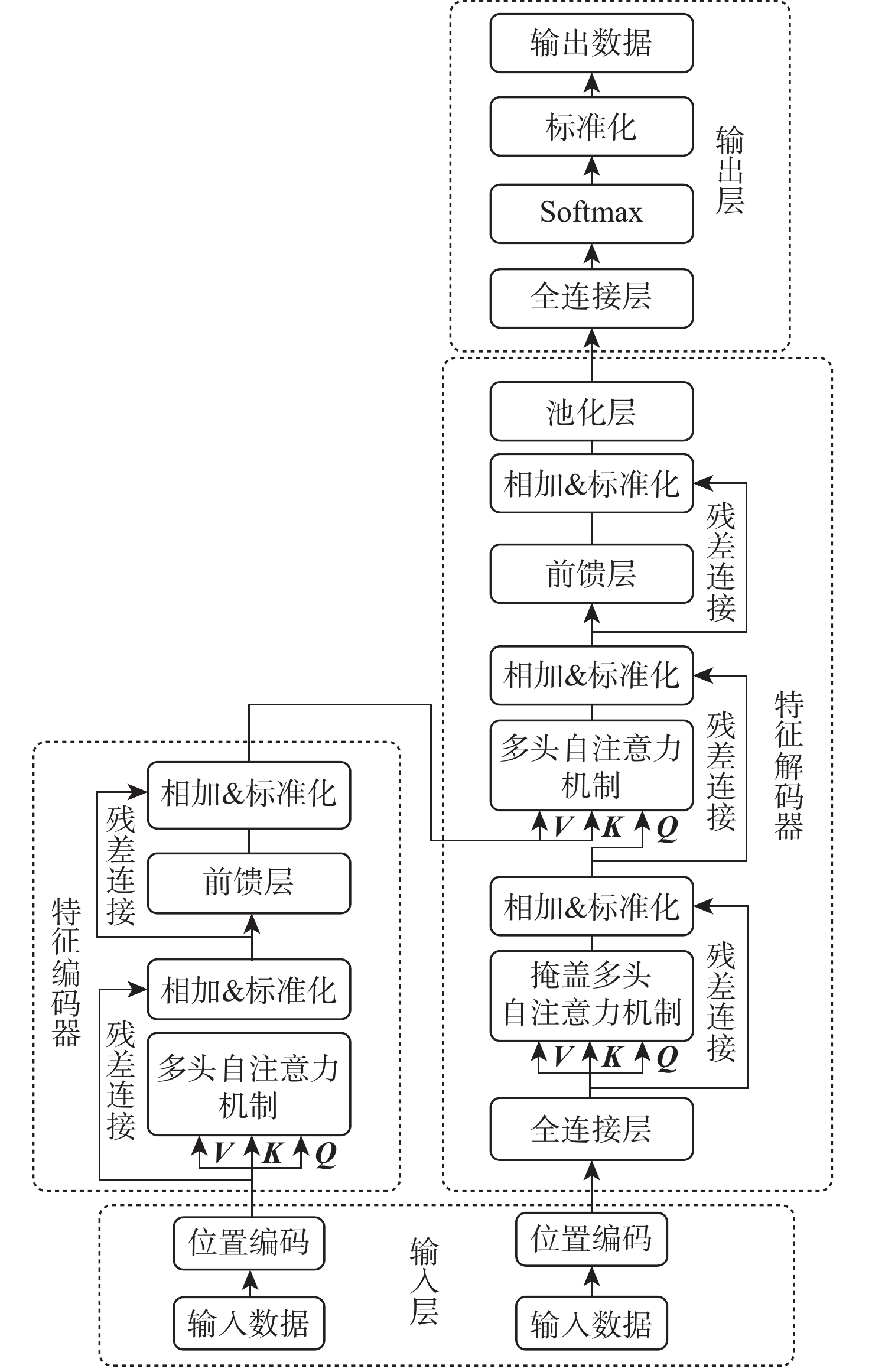
 下载:
下载:
